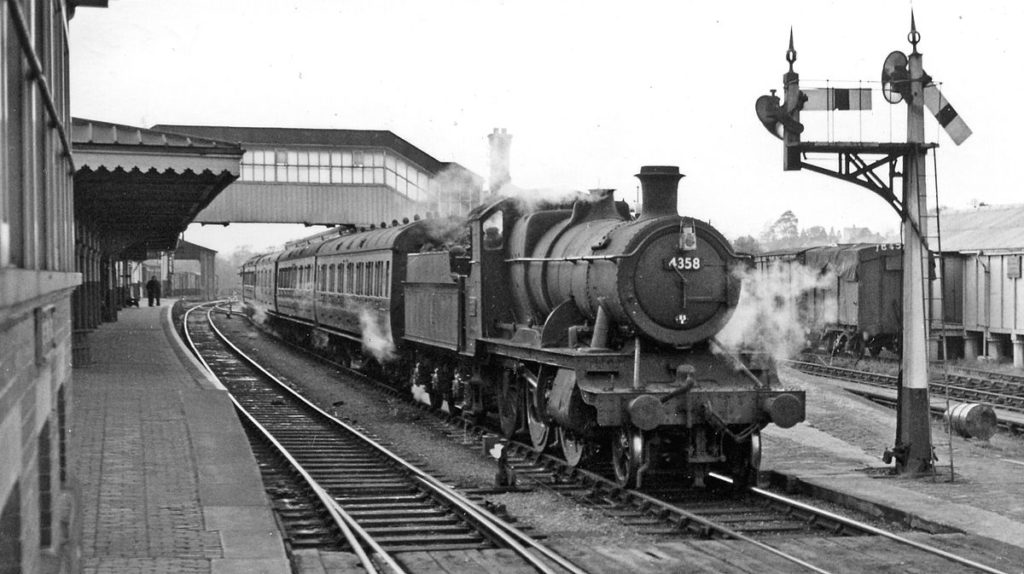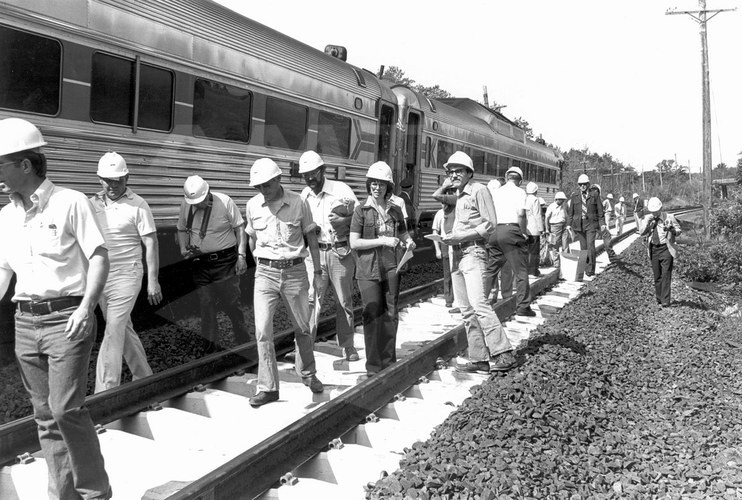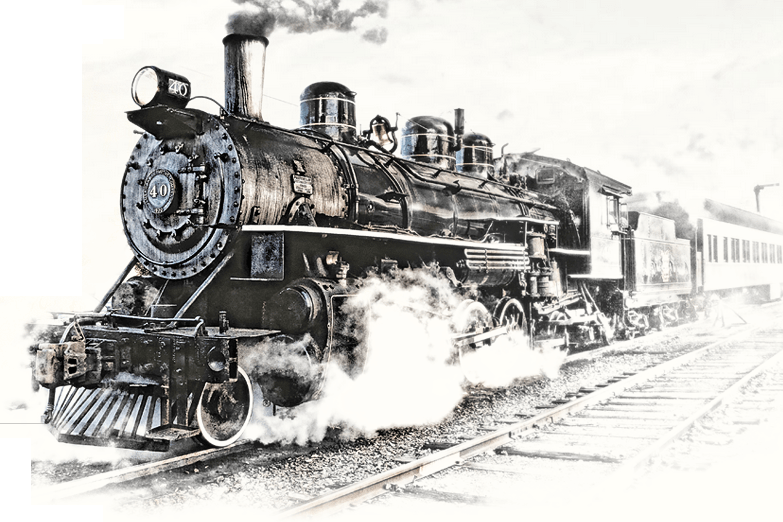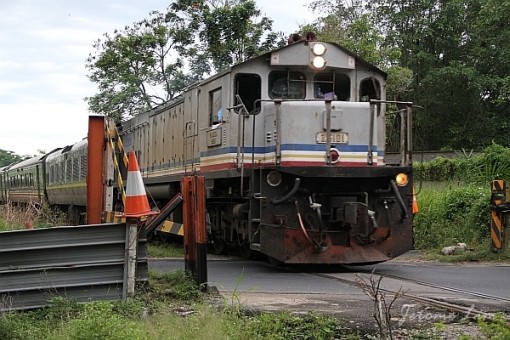It should always be remembered that George Stephenson was neither the inventor of steam locomotive nor the father of railways. But he played a great role in constructing public railways of modern days. Stephenson was rich and famous when he died at the age of 67 in 1848.
Traffic on 27th September 1825 in England
The first public railway in the history of world was opened for traffic on 27th September 1825 in England. The railway was run between Stockton and Darlington in the county of Durham. The planning and design of the railway line was carried out by Stephenson. The crowds had lined to watch this great achievement. The engine known as Locomotion No. 1 was only 6.60 t or about 66 kN in total weight. But it pulled a total of thirty-eight wagons behind it. Very important persons of the community were sitting in these wagons. To the astonishment of all at that time, the train attained a speed of 19.32 km p.h., even though the railway track was rough. The competition was held at Rainhill, a few kilometers outside Liverpool. History of Bangladesh Railways Thousands of spectators thronged to the railroad to have 3 view of this competition. The last locomotive was soon withdrawn from the competition. Sanspareil broke down and proved very wasteful in consumption of fuel. Novelty was a neat light engine with beautiful lines. But it also broke down.
The judges unanimously declared on October 8, 1829, the clumsy ever ready Rocket of Stephenson as the only engine which fulfilled all the conditions of the competition and the prize was awarded to Stephenson. At the final trial, the Rocket attained a speed of 38.62 km p.h. For Stephenson, October 8, 1829 was the proudest day of his life. Thus the idea of running railways with steam power was firmly rooted and a new era of railways began.
Liverpool and Manchester railway Opening
On the opening of the Liverpool and Manchester railway line on 15-9-1830, the Rocket was gaily decorated and it proudly drew the first passenger train over the line. For six years, the Rocket continued in service and it was employed afterwards at a coal mine. In 1862, it was acquired by the Government and placed on the exhibition at the Science Museum in London. In the beginning, the people considered railways unsafe for travelling purposes. It is surprising to note that Queen Victoria, as advised by her ministers, thought it to be safe to travel in railway, nearly after 17 years of the opening of the first railway in England. She took a journey from London to Slough on 13th June 1842. In Germany, there was a doctor who advocated that people will be turned mad, even if they see a moving train and unless hoardings were erected, the cow’s milk would turn sour. In India also, the famous economist Mr. R. C. Dutt, considered railways as a wasteful expenditure for the Indian conditions. The major items which make up the modern railways are stations, platforms, marshaling yards, locomotives, coaches, wagons, viaducts, tunnels, culverts, bridges, signals, signal cabins, sheds, restaurants, etc.
First Railway Opened
The first railway in France was opened in 1828 with horse as tractive power. The passenger traffic began in 1832 and steam engines were used as tractive power in 1844. The first railway in America was laid in 1833 between Mohawk and Hudson. The first railway in Ireland was laid and opened for traffic in 1834. The first German railway was opened from Nuremberg to Furth in the year 1835. The first railways in Netherlands from Amsterdam to Haarlem and in Italy from Naples to Portici were opened in 1839. The railways in Belgium date from 5th May 1835; in Austria from 1838; in Yugoslavia from 1846; in Switzerland and in Denmark from 1847; in Spain from 1848; in Norway and Africa from 1854; in Sweden from 1856; in Japan from 1872; in China from 1875; in Burma from 1877 and in Turkey from 1888. Future History of Bangladesh Railways

General purpose of convenience
For the purpose of convenience, the transport has been divided on the following three categories: (1) Land transport (2) Water transport (3) Air transport. Apart from the human porters and transport by the animals like horses, mules, donkeys, camels, etc., the two major important means of land transport are roads and railways. Table 1-1 gives a comparative idea about the merits and demerits of these two modes of land transport. For road transport, several kinds of carriages such as buses, auto rickshaws, bullock carts, trucks, etc. are used. The trucks have come to occupy a prominent place in the modern transport system and for short distances, they compete successfully with railways. The water transport possesses historical importance for making the cultural relations and growth of civilization. It can be subdivided into two categories: (i) History of Bangladesh Railways Inland water transportation (ii) History of Bangladesh Railways Ocean water transportation. (i) Inland water transportation: It is either in the form of river transportation or canal transportation. It is significant to note that the river transportation became popular in the country since 1855 and many commercial towns came into existence on the banks of important rivers like Ganges. In inland water transportation, certain restrictions and guidance are necessary. (ii) Ocean water transportation: It is adopted for trade and commerce. It is estimated that about 75 per cent of international trade is carried out by shipping. The development of navy force is intended for national defence. The ocean water transportation has no limitation and it possesses high flexibility.
Railways Mode Transport
With the introduction of railways as a mode of transport in 1853, the water transportation got some set back. But it is still considered as an important agency for the transport of men and materials by our country. In western countries, many people have started to think that thg railways will be obsolete in near future and their place will be taken by other modes of transport. Following two main points have led to this tendency of thinking: (1) Some of the activities of the railways are far behind the modern times. For instance, the level-crossings form a hindrance to the road traffic. (2) Out of all the means of transport, the railways were first to origin and hence it should retire like an old official and give place to means of more recent origin. More News : Video Tele-Conference in BD Army
Introduction History of Bangladesh Railways
History of Bangladesh Railways – We are at present so much used to the Railways that it will be rather astonishing to imagine the world without railways before 1825. Before that time, the land-road was the only source of travel and the maximum speed attained was that of the fastest horse. The History of Bangladesh Railways originated in England. The coaches were run on the road with a speed of about 13 to 16 kilometers per hour. In 1784, the mail-coaches carrying the mails were introduced. In seventeenth century, somebody now unknown, hit upon an idea of pulling the loads by a wheeled vehicle, put on the baulks of timber and drawn by horses. This was just the beginning of the development of the main principle on which the permanent way rests.
New Track Railway
After sometime, the iron plates were put up on the surface of the timber rails to prolong their life. The term plate-laying which is used at present to describe the process of laying of a new track, derives its origin from this early practice of laying iron plates on timbers. In 1789, the cast-iron rails resting on stone blocks were introduced. Thus the main idea of modern railways was fully developed before the end of eighteenth century and it was very much favoured since horses could pull heavier loads without much difficulty. Later on, the steam engines replaced horses and the locomotives began to act as the tractive power. It is understood that a French mechanic, named Nicholas Joseph Cugnot, was the first man to invent and construct a steam locomotive in the year 1769. Subsequently, the models of steam locomotives were prepared by William Murdoch, a Scotsman in or about 1786 and by Richard Trevithick, a Cornish Engineer in 1797. All these locomotives were designed for tractive work on roads only. In 1804, Trevithick designed and constructed the first locomotive for railways.
It should always be remembered that George Stephenson was neither the inventor of steam locomotive nor the father of railways. But he played a great role in constructing public railways of modern days. Stephenson was rich and famous when he died at the age of 67 in 1848.
Traffic on 27th September 1825 in England
The first public railway in the history of world was opened for traffic on 27th September 1825 in England. The railway was run between Stockton and Darlington in the county of Durham. The planning and design of the railway line was carried out by Stephenson. The crowds had lined to watch this great achievement. The engine known as Locomotion No. 1 was only 6.60 t or about 66 kN in total weight. But it pulled a total of thirty-eight wagons behind it. Very important persons of the community were sitting in these wagons. To the astonishment of all at that time, the train attained a speed of 19.32 km p.h., even though the railway track was rough. The competition was held at Rainhill, a few kilometers outside Liverpool. History of Bangladesh Railways Thousands of spectators thronged to the railroad to have 3 view of this competition. The last locomotive was soon withdrawn from the competition. Sanspareil broke down and proved very wasteful in consumption of fuel. Novelty was a neat light engine with beautiful lines. But it also broke down.
The judges unanimously declared on October 8, 1829, the clumsy ever ready Rocket of Stephenson as the only engine which fulfilled all the conditions of the competition and the prize was awarded to Stephenson. At the final trial, the Rocket attained a speed of 38.62 km p.h. For Stephenson, October 8, 1829 was the proudest day of his life. Thus the idea of running railways with steam power was firmly rooted and a new era of railways began.
Liverpool and Manchester railway Opening
On the opening of the Liverpool and Manchester railway line on 15-9-1830, the Rocket was gaily decorated and it proudly drew the first passenger train over the line. For six years, the Rocket continued in service and it was employed afterwards at a coal mine. In 1862, it was acquired by the Government and placed on the exhibition at the Science Museum in London. In the beginning, the people considered railways unsafe for travelling purposes. It is surprising to note that Queen Victoria, as advised by her ministers, thought it to be safe to travel in railway, nearly after 17 years of the opening of the first railway in England. She took a journey from London to Slough on 13th June 1842. In Germany, there was a doctor who advocated that people will be turned mad, even if they see a moving train and unless hoardings were erected, the cow’s milk would turn sour. In India also, the famous economist Mr. R. C. Dutt, considered railways as a wasteful expenditure for the Indian conditions. The major items which make up the modern railways are stations, platforms, marshaling yards, locomotives, coaches, wagons, viaducts, tunnels, culverts, bridges, signals, signal cabins, sheds, restaurants, etc.
First Railway Opened
The first railway in France was opened in 1828 with horse as tractive power. The passenger traffic began in 1832 and steam engines were used as tractive power in 1844. The first railway in America was laid in 1833 between Mohawk and Hudson. The first railway in Ireland was laid and opened for traffic in 1834. The first German railway was opened from Nuremberg to Furth in the year 1835. The first railways in Netherlands from Amsterdam to Haarlem and in Italy from Naples to Portici were opened in 1839. The railways in Belgium date from 5th May 1835; in Austria from 1838; in Yugoslavia from 1846; in Switzerland and in Denmark from 1847; in Spain from 1848; in Norway and Africa from 1854; in Sweden from 1856; in Japan from 1872; in China from 1875; in Burma from 1877 and in Turkey from 1888. Future History of Bangladesh Railways

General purpose of convenience
For the purpose of convenience, the transport has been divided on the following three categories: (1) Land transport (2) Water transport (3) Air transport. Apart from the human porters and transport by the animals like horses, mules, donkeys, camels, etc., the two major important means of land transport are roads and railways. Table 1-1 gives a comparative idea about the merits and demerits of these two modes of land transport. For road transport, several kinds of carriages such as buses, auto rickshaws, bullock carts, trucks, etc. are used. The trucks have come to occupy a prominent place in the modern transport system and for short distances, they compete successfully with railways. The water transport possesses historical importance for making the cultural relations and growth of civilization. It can be subdivided into two categories: (i) History of Bangladesh Railways Inland water transportation (ii) History of Bangladesh Railways Ocean water transportation. (i) Inland water transportation: It is either in the form of river transportation or canal transportation. It is significant to note that the river transportation became popular in the country since 1855 and many commercial towns came into existence on the banks of important rivers like Ganges. In inland water transportation, certain restrictions and guidance are necessary. (ii) Ocean water transportation: It is adopted for trade and commerce. It is estimated that about 75 per cent of international trade is carried out by shipping. The development of navy force is intended for national defence. The ocean water transportation has no limitation and it possesses high flexibility.
Railways Mode Transport
With the introduction of railways as a mode of transport in 1853, the water transportation got some set back. But it is still considered as an important agency for the transport of men and materials by our country. In western countries, many people have started to think that thg railways will be obsolete in near future and their place will be taken by other modes of transport. Following two main points have led to this tendency of thinking: (1) Some of the activities of the railways are far behind the modern times. For instance, the level-crossings form a hindrance to the road traffic. (2) Out of all the means of transport, the railways were first to origin and hence it should retire like an old official and give place to means of more recent origin. More News : Video Tele-Conference in BD Army
Introduction History of Bangladesh Railways
History of Bangladesh Railways – We are at present so much used to the Railways that it will be rather astonishing to imagine the world without railways before 1825. Before that time, the land-road was the only source of travel and the maximum speed attained was that of the fastest horse. The History of Bangladesh Railways originated in England. The coaches were run on the road with a speed of about 13 to 16 kilometers per hour. In 1784, the mail-coaches carrying the mails were introduced. In seventeenth century, somebody now unknown, hit upon an idea of pulling the loads by a wheeled vehicle, put on the baulks of timber and drawn by horses. This was just the beginning of the development of the main principle on which the permanent way rests.
New Track Railway
After sometime, the iron plates were put up on the surface of the timber rails to prolong their life. The term plate-laying which is used at present to describe the process of laying of a new track, derives its origin from this early practice of laying iron plates on timbers. In 1789, the cast-iron rails resting on stone blocks were introduced. Thus the main idea of modern railways was fully developed before the end of eighteenth century and it was very much favoured since horses could pull heavier loads without much difficulty. Later on, the steam engines replaced horses and the locomotives began to act as the tractive power. It is understood that a French mechanic, named Nicholas Joseph Cugnot, was the first man to invent and construct a steam locomotive in the year 1769. Subsequently, the models of steam locomotives were prepared by William Murdoch, a Scotsman in or about 1786 and by Richard Trevithick, a Cornish Engineer in 1797. All these locomotives were designed for tractive work on roads only. In 1804, Trevithick designed and constructed the first locomotive for railways.
It should always be remembered that George Stephenson was neither the inventor of steam locomotive nor the father of railways. But he played a great role in constructing public railways of modern days. Stephenson was rich and famous when he died at the age of 67 in 1848.
Traffic on 27th September 1825 in England
The first public railway in the history of world was opened for traffic on 27th September 1825 in England. The railway was run between Stockton and Darlington in the county of Durham. The planning and design of the railway line was carried out by Stephenson. The crowds had lined to watch this great achievement. The engine known as Locomotion No. 1 was only 6.60 t or about 66 kN in total weight. But it pulled a total of thirty-eight wagons behind it. Very important persons of the community were sitting in these wagons. To the astonishment of all at that time, the train attained a speed of 19.32 km p.h., even though the railway track was rough. The competition was held at Rainhill, a few kilometers outside Liverpool. History of Bangladesh Railways Thousands of spectators thronged to the railroad to have 3 view of this competition. The last locomotive was soon withdrawn from the competition. Sanspareil broke down and proved very wasteful in consumption of fuel. Novelty was a neat light engine with beautiful lines. But it also broke down.
The judges unanimously declared on October 8, 1829, the clumsy ever ready Rocket of Stephenson as the only engine which fulfilled all the conditions of the competition and the prize was awarded to Stephenson. At the final trial, the Rocket attained a speed of 38.62 km p.h. For Stephenson, October 8, 1829 was the proudest day of his life. Thus the idea of running railways with steam power was firmly rooted and a new era of railways began.
Liverpool and Manchester railway Opening
On the opening of the Liverpool and Manchester railway line on 15-9-1830, the Rocket was gaily decorated and it proudly drew the first passenger train over the line. For six years, the Rocket continued in service and it was employed afterwards at a coal mine. In 1862, it was acquired by the Government and placed on the exhibition at the Science Museum in London. In the beginning, the people considered railways unsafe for travelling purposes. It is surprising to note that Queen Victoria, as advised by her ministers, thought it to be safe to travel in railway, nearly after 17 years of the opening of the first railway in England. She took a journey from London to Slough on 13th June 1842. In Germany, there was a doctor who advocated that people will be turned mad, even if they see a moving train and unless hoardings were erected, the cow’s milk would turn sour. In India also, the famous economist Mr. R. C. Dutt, considered railways as a wasteful expenditure for the Indian conditions. The major items which make up the modern railways are stations, platforms, marshaling yards, locomotives, coaches, wagons, viaducts, tunnels, culverts, bridges, signals, signal cabins, sheds, restaurants, etc.
First Railway Opened
The first railway in France was opened in 1828 with horse as tractive power. The passenger traffic began in 1832 and steam engines were used as tractive power in 1844. The first railway in America was laid in 1833 between Mohawk and Hudson. The first railway in Ireland was laid and opened for traffic in 1834. The first German railway was opened from Nuremberg to Furth in the year 1835. The first railways in Netherlands from Amsterdam to Haarlem and in Italy from Naples to Portici were opened in 1839. The railways in Belgium date from 5th May 1835; in Austria from 1838; in Yugoslavia from 1846; in Switzerland and in Denmark from 1847; in Spain from 1848; in Norway and Africa from 1854; in Sweden from 1856; in Japan from 1872; in China from 1875; in Burma from 1877 and in Turkey from 1888. Future History of Bangladesh Railways

General purpose of convenience
For the purpose of convenience, the transport has been divided on the following three categories: (1) Land transport (2) Water transport (3) Air transport. Apart from the human porters and transport by the animals like horses, mules, donkeys, camels, etc., the two major important means of land transport are roads and railways. Table 1-1 gives a comparative idea about the merits and demerits of these two modes of land transport. For road transport, several kinds of carriages such as buses, auto rickshaws, bullock carts, trucks, etc. are used. The trucks have come to occupy a prominent place in the modern transport system and for short distances, they compete successfully with railways. The water transport possesses historical importance for making the cultural relations and growth of civilization. It can be subdivided into two categories: (i) History of Bangladesh Railways Inland water transportation (ii) History of Bangladesh Railways Ocean water transportation. (i) Inland water transportation: It is either in the form of river transportation or canal transportation. It is significant to note that the river transportation became popular in the country since 1855 and many commercial towns came into existence on the banks of important rivers like Ganges. In inland water transportation, certain restrictions and guidance are necessary. (ii) Ocean water transportation: It is adopted for trade and commerce. It is estimated that about 75 per cent of international trade is carried out by shipping. The development of navy force is intended for national defence. The ocean water transportation has no limitation and it possesses high flexibility.
Railways Mode Transport
With the introduction of railways as a mode of transport in 1853, the water transportation got some set back. But it is still considered as an important agency for the transport of men and materials by our country. In western countries, many people have started to think that thg railways will be obsolete in near future and their place will be taken by other modes of transport. Following two main points have led to this tendency of thinking: (1) Some of the activities of the railways are far behind the modern times. For instance, the level-crossings form a hindrance to the road traffic. (2) Out of all the means of transport, the railways were first to origin and hence it should retire like an old official and give place to means of more recent origin. More News : Video Tele-Conference in BD Army
 আমি বাংলার কথা বলি
আমি বাংলার কথা বলি



